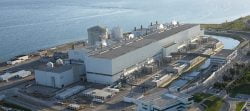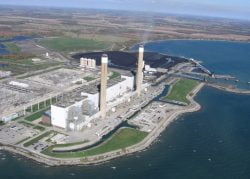In Part 2 of our series on electricity costs, we examine why they have gotten so high, and who or what is responsible.
In our last post, we mentioned that the Global Adjustment (GA) now makes up the bulk of an Ontario electricity bill and is chiefly responsible for the huge rise in those bills, so any examination of what has made our bills so high has to look at the composition of the GA.
A significant part of the GA is due to contractual rates paid to suppliers of green energy. The actual fair market rate for electricity in Ontario, or HOEP (Hourly Ontario Energy Price), was calculated at an average of 2.36¢/kWh in 2015. The IESO (Independent Electricity System Operator, the organization responsible for managing Ontario’s electrical system) paid wind producers between 6 and 13¢/kWh, as they had been contractually obligated to. The difference went into the GA fee. Many solar producers had signed 20- or even 30-year agreements with the government to sell power at 80¢/KWh. The fair market rate for that power was still 2.36¢/KWh. That 78-cent difference also went into the GA fee.
The rationale behind these high rates was to address a market failure. Green energy is more expensive to generate than fossil-fuel energy, and no energy producer would want to pay the expense of building green generating capacity only to run it at a huge loss. The government therefore incentivized green energy production by paying rates that would make it compelling for producers. The taxpayers would effectively subsidize a socially useful activity, like tax credits for charitable or political contributions, or subsidizing post-secondary tuition – society benefits when more people are charitable, well-educated, and support a competitive political system, so society should foot some of the bill. How much, of course, is highly debatable, and hotly debated.
Last year, Ontario sold 22.6 billion kWh of electricity to neighbouring provinces and states, and we did so at the fair market rate of 2.36¢/KWh, even though we’d bought it from the producers at rates that were sometimes much higher. According to Global News, this produced a loss of $1.7 billion.
Contradicting that account, the Independent Electricity System Operator (IESO)’s finding is that that trade actually produced a benefit of approximately $230 million to Ontario in the same year. The discrepancy might be explained by the government’s inclusion of economic benefits – we may have lost $1.7 billion in the direct sale, but if the economic activity that that power generation produced was worth $1.93 billion, then our net gain was $230 million.
Why do we trade with our neighbours at such rates? First, we should explain why we trade at all. Power demands fluctuate greatly over the course of the year and the day. We use more power in the summer than in the winter, due to the demands of air conditioning. In the course of a day, power demand starts to increase at around 5am, holds a plateau from 9am to about 6pm, then rises slightly as people return home from work, and then drops sharply from about 9pm until 3am. The difference between the 6pm peak and the 3am valley can be as much as 5,000 MW – the four-reactor nuclear power station at Darlington puts out 3,500, for comparison.

Ontario power demand over time. Image credit: IESO
One solution is to scale power plant production with demand, as a car engine responds to the gas pedal. However, not all plants can adjust to changing loads quickly. Wind power depends entirely on the wind – a becalmed turbine produces no power. Solar delivers good output on a cloudless summer’s day, a less during overcast days or in winter, and none at night. The output of nuclear plants can be adjusted (a procedure known as load-following), but this is very inefficient as the vast majority of the cost of a nuclear power plant does not come from actually running the reactor – it is much more cost-effective to run a reactor at maximum power for baseload, and to have other power sources reduce their output instead. Additionally, particularly with older designs, actually adjusting and stabilizing the reactor at a lower power level is difficult and can take hours or even days.

The Chernobyl accident was caused when attempts to stabilize the reactor at a very low power level failed. Photo credit: Associated Press
Because not all of Ontario’s generating capacity can be easily adjusted, it makes more sense to sell excess power to neighbours than to shut plants down at great expense. We do need to avoid excess generation, since power supply above about 5 per cent of demand damages equipment (if you’ve ever seen a 110v device plugged into a 220v outlet, you will have some idea of how). Automated systems in power plants and grid distribution are constantly adjusting output to keep power delivery within acceptable margins.
When Ontario demands more power than its generation can handle, we buy it from our neighbours. It’s much cheaper to buy power from a neighbour than to build a new plant and to leave it idle for fifteen hours a day. This is why, over the course of a year, we see significant power imports and exports from the same provinces and states. When we have excess, we sell to them; when we can’t meet demand, we buy. Over a year, the sales and purchases can end up looking almost the same, like we simply traded an apple for an apple. What actually happened was that our neighbour was hungry and we offered them a spare apple; later, we were hungry and our neighbour had a spare of their own, so they offered it to us. Nobody went hungry and no apples went to waste, although when the total trades are examined, they look superfluous.
Some power plants can actually scale back or idle during low demand. Hydro plants can easily and quickly adjust the output by simply allowing more or less water through the turbines. Some older coal plants can also adjust, although the process is inefficient, and we don’t use coal in Ontario anymore anyway. Single-cycle gas plants, based on turbines, can also load-follow and adjust their output, although they are more inefficient than other plants and are generally only used for this purpose. Lastly, as noted above, some nuclear reactor designs can load-follow, although it makes little economic sense given that running costs are such a small fraction of the expense of a nuclear power plant.
When power plants are asked to scale back or idle due to low demand (say, a wind turbine generating power from strong winds at night when there is little demand), the government has to honour their contract if that contract states they will be paid for the power anyway. These producers are paid on their potential output, not what was actually delivered. In essence, at off-peak times we’re paying power plants not to produce power.
The problem is that the government is locked into contracts with these providers, who built power plants on the understanding that they would receive these payments for the lifetime of the contract. If they are broken now, not only could it put those producers out of business, it would also be a tremendous deterrent to any future power plant construction. More likely, those providers would simply sue the government, and their settlements or awards (not to mention the legal fees) would be paid by the taxpayers. As businesspeople, we understand how important it is to honour legal contracts.
Why pay power plants not to generate power? Why sign these contracts in the first place? The first reason is that you do need a certain amount of reserve capacity to be on-call. IESO is very good at predicting demand, but capacity can’t exceed demand by more than 5 per cent, and there is always a chance that an accident at a major generating station could take it off-line, or that demand could suddenly spike for some unforeseen reason, and reserve power is needed.
Another reason is that, with current power rates, renewable energy sources are not cost-competitive. As we said above, without these incentives and guarantees, no private-sector firm would build or operate a green plant. The government must find a way to make it worth their while. It’s the same with hybrid or electric vehicles, for instance. Right now, they cost significantly more than gasoline-powered models, so the government incentivizes them with tax credits.
These wrinkles are a primary reason why conservation policies have often failed. Since plants are paid regardless of whether they produce energy, and since power consumption is a much smaller part of a bill, decreasing power usage does very little to lower bills. We pay if we use the power, or if we don’t. There’s little financial incentive for Ontario residents or businesses to reduce their power consumption.
The GA also covers a host of general conservation programs. These include things like tax credits for high-efficiency appliances or LED light bulbs, or recycling old appliances and batteries, the cost of all of which is rolled into your GA fee. Again, these are not all inadvisable programs. Many, if not most, are environmentally responsible and offer benefits to businesses. It’s merely that the government has chosen to fund them through hydro bills rather than out of general tax revenue. The rationale is that, since charging people to recycle their batteries would just result in all used batteries ending up in landfills (for instance), putting the cost on to hydro bills would at least come closer to charging those who actually incurred the costs than paying for it out of general tax revenues would. However, a fairer option might be charging a recycling fee for new batteries, just as environmental handling fees were levied on new electronics in an admittedly flawed scheme. These are policy questions which should be examined so that government can make an economically informed decision.
Smart meters were supposed to help conservation by allowing time-of-use billing and producing more accurate bills. They differ from older interval or time-of-use meters in that they are capable not just of automated meter reading, but of real-time or near-real-time usage reporting, power outage notification, and power quality monitoring. In theory, they mean an end to estimated billing and can supply data that actually helps consumers lower their bills.
These meters allow time-of-use pricing, since a smart meter can track consumption by the hour. Time-of-use pricing enables power companies to incentivize the use of electricity when demand is low, which you can take advantage of by running appliances at night, for instance. Peak demand is lower and off-peak is higher, which means the demand-by-hour curve is flatter and we need fewer overall power stations (since the number we need is – trade notwithstanding – equal to peak demand, not average demand), reducing capital costs. It would also theoretically lower bills by reducing the amount of power that Ontario has to buy from neighbours at peak times, when prices are higher, and could reduce the power company payroll through automation.
Unfortunately, they didn’t work very well, particularly in rural areas where the distances were often too great for the meters to report back reliably. Many rural customers complained of highly inaccurate reporting. Rather than more accurate bills, some customers were massively over-billed, while others didn’t receive bills for months. By the beginning of 2015, there were almost 10,000 billing complaints alone resulting from smart meters. Hydro One found the rural units so unreliable that it went back to manually reading 36,000 of them at the start of 2016. There were even concerns over fire risk leading to the removal of several thousand units.
The end result was a $2 billion bill for very little gain. Ontario’s auditor-general roundly criticized the program for being undertaken without a cost-benefit analysis and with a huge overestimation of the benefits. To add insult to injury, the smart meters resulted in only a modest impact on peak power demand, and had absolutely no impact on energy conservation.
While we’re on the subject of policy missteps, we promised in the last post that we would get into the gas plant scandal here. To cut a long story short, after closing the Lakeview coal-fired station in 2005, the Ontario government planned two new gas-fired generating stations in Mississauga and Oakville to make up the generating capacity for the GTA, but there were significant local environmental objections and the plants were cancelled. The government stated that the cost of this cancellation was $230 million; the auditor-general later found that it was actually between $950 million and $1.09 billion.
The reason why it would cost so much not to build a power plant is easy to understand for business owners. When you begin work on something for your business, such as a new store or a new website, you sign contracts for goods and services to make it happen. The other businesses you contract with will invest their own money and resources into your project, to be recouped when you pay them for it. If you then change your mind, they do not want that money and those resources to be lost, so they will usually write cancellation penalties into a contract.
If you change your mind, your contractors are legally entitled to whatever cancellation penalties are in their contracts, and when the contractors are going to incur their own costs on a scale associated with building a power plant, of course they will have made sure there are cancellation penalties specified. This is a significant lesson to be borne in mind by anyone advocating simply breaking other contracts, as was proposed by Tim Hudak when he was Ontario PC leader.
The environmental objections that led to the cancellation highlight a major problem with new plant construction – the NIMBY factor (an acronym for Not In My Back Yard – see also BANANA, or Build Absolutely Nothing Anywhere Near Anyone, and CAVE, or Citizens Against Virtually Everything).
Everyone wants cheap electricity, but nobody wants to live near a power station.
Fossil-fuel fired power stations churn CO2, pollutants and carcinogens into the atmosphere. Nuclear plants are extremely safe, statistically speaking, but the few major accidents that have occurred (Fukushima, Chernobyl, Windscale, or Three Mile Island, for instance) were spectacular and horrifying, and dampened everyone’s enthusiasm for living near a reactor. People find the noise pollution from wind turbines irksome – although peer-reviewed research has found no evidence that they cause health problems – and the turbines themselves are aesthetically unappealing and subjectively spoil rural landscapes.
Solar stations are expensive, use a lot of land, and are hard to scale up to fulfill the demands of an industrialized economy. Hydro power is very site-limited – if there’s no major river that can be dammed, there’s no hydro power, and the resulting lakes destroy the local environment. The Aswan dam in Egypt infamously necessitated the relocation of many ancient archaeological sites and simply flooded the rest, for instance.
We also promised to go into the nuclear situation further in this post. Phasing out coal has left Ontario much more reliant on nuclear power, but nuclear generation is very expensive, and our reactor fleet is aging. This is costing us – and it will cost us a lot more in the near future.
At the end of 1997, the older four Pickering A reactors – half of the reactors at the facility – were shut down, and a planned restart supposed to cost $780 million was abandoned half-way through in 2005 after numerous delays and a six-fold cost overrun. This left only two of the four ‘A’ reactors operating again, at a final cost of $2.5 billion (several times the projected cost for only half the promised capacity). Ontario Power Generation (OPG) currently plans to proceed with refurbishing Pickering B, and to keep the plant running until 2024 so that further refurbishment at Darlington can proceed without impacting power delivery.

Darlington nuclear generating station. Photo credit: Ontario Power Generation
The Darlington refurbishment is forecast to cost $12.8 billion, part of a total $25 billion that the government plans to spend on nuclear refurbishment over the next 15 years. We spoke extensively with OPG about the refurbishment, and one reason the cost is so much higher than Pickering is that lessons have been learned. OPG has built safeguards into their plan, such as not beginning work on reactors 2, 3 and 4 until the refurbishment of 1 is complete (thus offering an accurate per-unit cost – work on the remaining reactors will overlap), building a full-scale model of the reactor unit to train refurbishment personnel and contractors, and significant oversight and reporting. Two independent oversight organizations have been established, one – Burns & McDonnel Modus – reporting to the Project Executive and the OPG Board of Directors, and the other – Milt Caplan – reporting directly to the Ministry of Energy.
Ontario Clean Air Alliance chair and former Toronto Hydro commissioner Jack Gibbons claimed that the province could save $900 million if it instead chose to shut Pickering down and decommission its reactors in 2018 when the license expires, instead of running the plant for an additional 15 years after the end of its 30-year design life. Even if that were true, Ontario only generates a surplus of power during the winter, and we cannot meet the province’s electricity needs if we decommission Pickering, not to mention capacity for future developments such as mass adoption of electric vehicles (EVs). The current system can absorb a million EVs, but if they were all to be charged at 5:30pm when everyone returns from work, they would cause brownouts in our current grid.
Other plans to build four brand-new reactors at Darlington have been abandoned due to high capital costs. Building nuclear reactors is an expensive proposition. In 2009, the cost to build a new nuclear plant had risen to $9 billion USD per unit. Nuclear plants are extremely efficient – a nuclear reactor can generate up to three million times as much energy from a kilogram of uranium as a coal-fired station can from a kilogram of coal – but they are also extremely complex and expensive installations with a very high start-up cost (although running costs are low). The capital cost has to include the costs of waste disposal and reactor decommissioning, whereas fossil-fuel power plants are able to externalize the costs of their emissions. Coal-fired generation in Ontario cost the healthcare system $4.3 billion in dealing with the health consequences of the pollution, for instance; nuclear plants must entirely contain their own pollution.
In 2001, Ontario had five coal-fired generating stations with a total of 19 separate units, contributing 8,800 MW to the grid. Between 2001 and 2014, all were gradually shut down. The IESO was in charge of the process and, to ensure a constant supply, a number of gas generators were built and had to demonstrate consistent, reliable performance before the IESO would allow the shut-down of the coal plants they were replacing.

Ontario’s Nanticoke Generating Station, shut down in 2013. Photo credit: Ontario Power Generation
Originally, in 2003, the Ontario government announced that they would phase out coal by 2007. Critics said this was too soon, and in 2005, the government pushed the target date to 2009, citing reliability concerns, and then to 2014. That date was kept, with the last Ontario coal-fired station being shut down in 2014 (since recommissioned, and now fueled by biomass).
The shortfall was made up by 1,500 MW of nuclear capacity (by refurbishing two units at Bruce Power and returning them to operational status in 2012), by building an additional 5,500 MW worth of natural gas plants, and by procuring an additional 5,500 MW of non-hydro renewable energy sources. Obviously these weren’t free, and the cost to build this new generating capacity so that we could shut down coal-fired stations (only Thunder Bay and Atikokan were repurposed to run on biomass; Lakeview was demolished, Nanticoke was decommissioned, and although alternative uses were considered for Lambton, the search was abandoned and the facility will be decommissioned in 2017) is reflected in our electricity bills.
So, to summarize, there are many causes. We delayed what was an obviously necessary shift away from coal and fossil fuels for too long, then we had to enact a policy change very quickly, and to do so was costly. Guaranteed prices for green energy providers are very expensive. They were felt to be necessary to attract investment in green power generation, and whether that was true or not, we are obligated to pay them now. We’re selling power for less than we pay to generate it, and yet we need those trades to avoid brownouts. We wasted a lot of money on smart meters. We wasted a lot of money cancelling gas plants. We’re struggling to meet the needs of an industrial economy without using cheap coal power, when green energy has trouble scaling up and nuclear power is expensive. We’ve rolled a bunch of conservation programs into hydro bills that don’t necessarily need to be. There are new problems, and there are decades-old problems.
What can we do? Check back for Part 3, where we talk about potential solutions.



